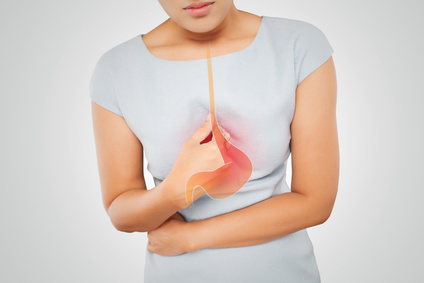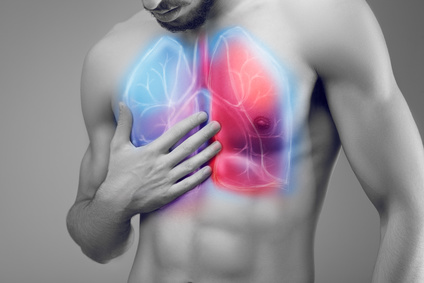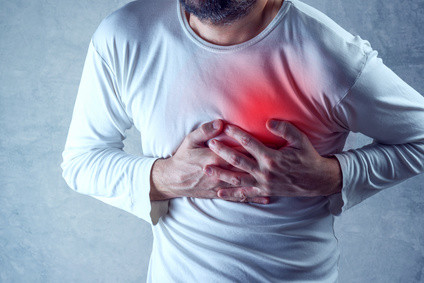Pain Above Breasts (Right and Left) – Causes and Symptoms
Pain anywhere on the chest is a cause for concern and should always be taken seriously. Two vital organs, namely the heart and lungs, are located in the chest. Therefore pain in the chest may be due to a lung or heart disease which can be deadly. However, chest pain is not always a life threatening symptom. Sometimes even severe chest pain can be due to non-lethal conditions like acid reflux.
Chest Pain Around the Breasts
Identifying the exact location of chest pain is helpful in diagnosing a cause. The type of pain and also other symptoms can also be helpful but sometimes misleading. For example, a burning chest pain is usually associated with chest muscle strain if it is on the surface or with acid reflux (heartburn) if it is felt internally. There are instances where this is not the case and heart attack chest pain can be burning in nature and therefore mistaken for heartburn due to acid reflux.

It is not uncommon to use the breasts as a landmark when assessing chest pain. The pain can be between the breasts (cleavage pain), below the breasts, in or behind the breast and there can be chest pan above the breasts. However, there may be some degree of variation when using the breast as a landmark. This is more likely to be an issue for women due to the significant difference in breast size among individuals.
Organs Above the Breast
On the surface above the breast is the:
- Skin and subcutaneous fat
- Muscles and tendons
- Fascia
- Ligaments
- Ribs
- Clavicle (shoulder bone)
Deeper, within the chest cavity is the:
- Pleura (lining around the lungs)
- Lungs
The pericardium (lining around the heart), heart and great blood vessels, esophagus (food pipe) and other major structures like the sympathetic trunk like more towards the center of the chest.
Causes of Pain Above Breast
The causes of pain above the breast may be due to a problem of any of the organs and structures mentioned above. We can divided the causes from the chest wall on the surface to the internal organs like the heart and lungs within the chest cavity.
However, it is important to note that the breast itself may be the source of the pain, even if the pain is felt above it. Some of the more likely causes of chest pain above the breast have been discussed in detail below but various other conditions also need to be considered.
Always consult with a medical doctor about chest pain, irrespective of its exact location or nature. Chest pain that occurs with difficulty breathing, dizziness and confusion requires emergency medical attention. One of the most common types of chest pain, heartburn, does not occur with any of these symptoms. Furthermore heartburn is usually central (center of the chest) rather than presenting as side chest pain or pain above the breasts.

Chest Wall
The chest wall if composed of the skin on the surface, fat underneath the skin, connective tissue, muscles, tendons, ligaments, cartilages, joints and bones. Blood vessels and nerves also run in the chest wall.
- Trauma: Injury to the chest wall is one of the leading causes of superficial pain. The pain is usually at the site of the injury. Any trauma, like a blow to the chest above the breast, will therefore be responsible for pain above the breast. Rib and clavicle (collarbone) fractures may be some of the more severe and painful consequences of chest wall injuries.
- Muscle Strain: The pectoral muscles are the largest muscles of the chest wall lying above, behind and below the breasts. This muscle may be strained with overactivity or exertion usually involving certain movements of the arms. This can cause muscle pain around the breast.
- Costochondritis: Inflammation of the joints between the ribs and sternum, including the cartilage between these bones, is known as costochondritis. It typically causes pain at the center of the chest (breastbone pain).
- Shingles: Reactivation of the chickenpox virus can cause inflammation of the skin and underlying tissue, particularly nerves, that may result in painful blisters and skin rash. The chest is commonly affected site and it tends to occur in certain bands (dermatomes).
Read more on chest wall pain.
SYMPTOMS
- Rash, redness, bruising and/or deformity on the chest wall.
- Pain with deep inhalation.
- Pain when moving arms.
- Tenderness of parts of the chest wall.
Breasts
The breasts are technically part of the chest wall. However, there are a variety of breast conditions that may cause chest pain. Normally this pain is in the breast itself but it can also extend to any part above, below or on either side of the breast. These causes can vary from mastitis (infection of the breast), breast cysts, benign tumors of the breast and even breast cancer.
Read more on breast pain.
SYMPTOMS
- Breast secretion or discharge
- Enlarged breast
- Nipple deformity
- Breast rash
- Breast lumps
- Swollen armpit lymph nodes
Lungs
The lungs are the largest organs within the chest cavity. Any disease or disorder of the lungs, particularly when the upper parts of the lungs are involved, can account for chest pain above the breasts. Similarly diseases of the lining around the lungs (pleura) can also be the cause of pain.

- Pleuritis: Also known as pleurisy, this is inflammation of the pleura that surrounds the lungs. It is more likely to occur due to infections or with injury to the pleura that is mostly seen with trauma, such as surgery.
- Bronchitis: Inflammation of the tubes carrying air into and out of the lungs can be responsible for chest pain above the breast. Often this pain may be at the center of the chest but the bronchial tree extends deep into the lungs
- Pneumonia: The lung itself may become inflamed and this is known as pneumonia. Most of the time it is a result of infections, particularly viral or bacterial. This includes conditions like pulmonary TB (tuberculosis). The bronchi may also be involved and this is collectively referred to as bronchopneumonia.
- Chemical pneumonitis: This is inflammation of the lung caused the exposure to certain chemicals. It is more likely to occur with inhaling smoke fumes, pool chlorine, bleachers and drain cleaners as well as pesticides, certain oils and agricultural dusts. Stomach acid may also be responsible as a result of vomit or reflux that enters the lungs (aspiration pneumonia).
- Lung cancer: A malignant tumor of the lung and/or parts of the bronchial tree may also cause chest pain. The pain tends to be the most intense at the part of the lung where the tumor is located. Tobacco smokers and those exposed to second hand smoke are at a greater risk of lung cancer.
SYMPTOMS
- Difficulty breathing
- Abnormal breathing sounds
- Cough
- Sputum (mucus) and bloody phlegm
- Low blood oxygen levels
Heart and Blood Vessels
Although most of the heart is located more centrally whereas the breasts are towards the sides of the chest (lateral), sometimes pain above the breast is due to heart problems or conditions of the great blood vessels.

- Pericarditis: Inflammation of the lining around the heart is known as pericarditis. It can occur with infections or injuries, including surgery to the chest cavity. Sometimes certain medication may also cause pericarditis.
- Carditis: A broad term for inflammation of the heart wall is carditis. This includes inflammation of the muscular layer (myocarditis), inner layer of the heart (endocarditis) as well as the outer layer (pericarditis). The valves may also be inflamed (valvulitis).
- Angina pectoris and heart attack: Both angina pectoris and a heart attack are commonly due to coronary artery disease. The narrowed heart arteries (coronary) arteries can supply sufficient blood to the heart wall and a portion of the tissue may be injured or there may be tissue death.
- Aortic dissection: Tearing of the inner wall of the aorta is known as an aortic dissection. The pain may extend above the breast when the arch of the aorta is affected. It is more likely to occur in older people or where there are pre-existing aortic diseases like an aortic aneurysm.
Read more on cardiac chest pain.
SYMPTOMS
- Shortness of breath
- Lightheaded or dizziness
- Chest pain with/without left arm pain or jaw pain
- Confusion
- Excessive sweating
- Loss of consciousness
Pain Above Right Breast
Pain above the right breast may be due to any of the causes mentioned above but usually does not arise with cardiovascular (heart and blood vessel) conditions. The heart lies in the middle of the chest and slightly to the left. Therefore pain above the right breast is not usually associated with the heart. Sometimes right shoulder pain can be caused by distant problems, like gallstones and other types of gallbladder diseases.
Pain Above Left Breast
Pain above the left breast may also be caused by any of the conditions mentioned above. Unlike pain above the right breast, a heart or blood vessel problem may also cause pain above the left breast. In fact when pain does occur in thsi region, it is important to rule out the heart as a possible cause particularly people who are at a high risk of a heart attack and other cardiac conditions.
References
- Chest pain. Harvard.edu
- Types of lung diseases. WebMD.com
- Breast pain. MayoClinic.org
Last updated on 28 October 2018.
